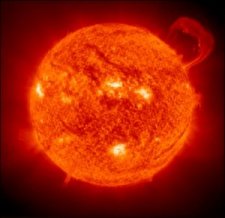Solar Activity

For 100s of years, scientists have measured this solar activity. The data lets them predict when the Sun's activity will next reach a peak. We call these peaks, solar maximums. A solar maximum takes place about every 11 years.
There are lots of ways of measuring the solar activity. One way is to count the number of sunspots on the Sun from day to day. Sunspots are dark areas on the surface of the Sun. They are darker because they have a lower temperature. When the Sun is more active, we see more sunspots. When the Sun is less active, we see fewer sunspots.
As well as sunspots, astronomers observe solar flares from the Sun. These take place when twisted magnetic field lines suddenly unwind.
Solar flares release a lot of energy. They can also fling large amounts of matter out from the Sun. If a flare reached the Earth, it would dump large amounts of electricity into the atmosphere. This would damage satellites in orbit around Earth. It could also cause power surges and affect radio transmissions on Earth. This is why it is vital for astronomers to monitor solar activity.

